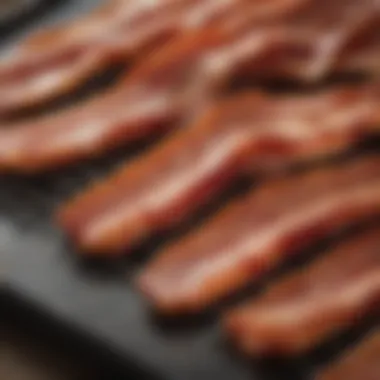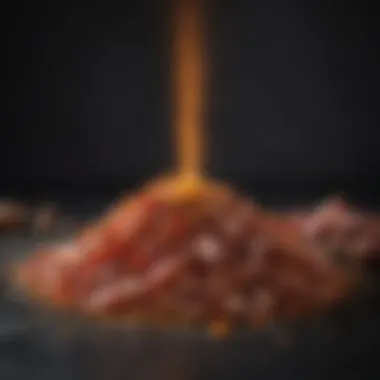Mastering Bacon: Cooking at 400 Degrees Fahrenheit


Intro
Cooking bacon is an art that can elevvate even the simplest breakfast. People often choose various methods for preparing bacon. However, cooking bacon at a specific temperature like 400 degrees Fahrenheit presents unique advantages and challenges. This method maximizes texture and flavor while ensuring efficient time usage.
When you select 400°F as your cooking temperature, you harness the ability to achieve crispy, yet tender bites. It is not just about heat; it involves strategy, technique, and slight maneuvering of ingredients. Some people might not realize the benefits, but analyzing comfort and craftsmanship elevates bacon cooking to new heights.
At this temperature, timing is crucial. Bacon can quickly shift from perfectly crispy to overly cooked within a minute. This guide provides detailed helps, valuable insights, and encouragement for those keen on perfecting this process.
Ultimately, this narrative explores key points related to preparing bacon efficiently while managing the routine demands of personal life. Now let’s examine the recipe highlight to instruct on making perfectly cooked bacon at 400 degrees.
Recipe Highlight
Bacon Bliss
Dive into the delicious realm of Bacon Bliss, a simple yet satisfying treat that enhances your morning routine.
Essential Ingredients:
- Thick-cut bacon strips
- Optional: black pepper, maple syrup, or chili flakes for added flavors
Estimated time to prepare:
Total time of about 20-25 minutes
Servings:
This recipe yields approximately 4 servings.
Step-by-Step Instructions
- Preheat the oven to 400 degrees Fahrenheit.
- Line a baking sheet with aluminum foil or parchment paper. This will make cleanup much easier.
- Arrange bacon strips in a single layer on the sheet, ensuring they do not overlap. This helps them cook evenly.
- Time for the oven! Slide the baking sheet into the preheated oven.
- Monitor closely for 15-20 minutes. The exact timing may differ based on bacon thickness and preferred crispiness.
- Using tongs, flip the strips halfway through cooking for optimal results.
- Take out the baking sheet from the oven. Allow the bacon to cool for a minute before transferring to a plate lined with paper towels for extra oil absorption.
For flawless bacon, keeping a close eye during the last 5 minutes is essential.
Common Mistakes to Avoid:
- Overcrowding the bacon.
- Ignoring the grease buildup; it can lead to smoke and burning.
- Not flipping halfway unless you prefer uneven crisping.
Variations and Substitutions
For additional flexibility in flavor and texture, consider these substitutions:
- Turkey bacon for a leaner alternative.
- Coconut aminos instead of traditional sauce, adding a unique twist.
- Vegan bacon options from various meat alternatives.
Amplify flavor by drizzling maple syrup before enjoy. Pair crispy bacon with pancake or fresh fruit for a well-rounded feast.
Time-Saving Cooking Tips
- Prep in advance: Cut the bacon into desirable sizes before cooking, saving minutes when ready to serve.
- Use a cooking rack set over the baking sheet to aid in grease collection, speeding up both cooking and clean-up processes.
- Batch cooking= cook multiple servings at once, freeze extras for busy weeks. Toast bacon in the oven and store in containers for easy access later.
Nutritional Information
- Calories: Approximately 200 calories per serving.
- Nutrients: High in protein, essential fats, and trace levels of vitamins.
- Saturating fat means moderation with dietary guidelines; ensure balance with vegetables or fruits.
This cooking method is not suitable for vegan or gluten-free diets unless specific products are used. Understanding the elements shall achieve satisfaction without undue fuss, ultimately leading to a surprising stretching of culinary possibilities.
Preface to Cooking Bacon


Cooking bacon is an essential step for many culinary enthusiasts. The method, temperature, and timing can significantly affect the taste and texture of this beloved ingredient. In this guide, we will investigate these aspects, focusing on cooking bacon at 400 degrees Fahrenheit. This temperature is known for its ability to cook bacon thoroughly while promoting an ideal crispiness without burning.
Understanding Bacon Varieties
Bacon comes in different types, and understanding these varieties is crucial for effective cooking. The most common types include:
- Streaky bacon: This is the most popular type, featuring layers of fat which helps create a crispy texture when cooked.
- Back bacon: A meatier option, containing more meat than fat. It can be leaner and often requires different cooking times compared to streaky bacon.
- Pancetta: An Italian version of bacon, which is cured but typically not smoked. It imparts a distinct flavor, requiring varied cooking techniques.
Each type of bacon cooks differently, so knowing the specific characteristics of your chosen variety is key. The cooking method needs to complement the bacon type you use, ensuring optimal results.
The Appeal of Cooking at Degrees
Cooking bacon at 400 degrees Fahrenheit has several benefits. First, this moderate temperature allows for an even cooking process, reducing the risk of burning the otherwise delicate slices. Here are several reasons why it's appealing:
- It offers a perfect balance between cooking speed and thoroughness.
- A consistent temperature yields uniformly cooked bacon, enhancing texture consistency.
- Less splatter occurs, making cleanup easier.
A large crowd often gravitates to this temperature because it manages heating times efficiently. Proper biscuits alongside crispy bacon at that target temperature is a comforting option in busy life and morning routines. Thus, figuring out how this technique best fits into meal preparation can enrich one’s culinary experiences.
Preparing to Cook Bacon
Cooking bacon may seem straightforward, but preparation is crucial for achieving the best results. This phase sets the foundation for your cooking process and enhances your overall experience. Understanding what tools you need and the type of bacon you select can significantly affect both taste and texture. These elements are essential to ensure that every slice is flavorful and cooked to perfection.
Essential Cooking Tools
Having the right tools can make the task of cooking bacon not only easier but also more enjoyable. Below are some essential items you may consider:
- Baking Sheet: A sturdy baking sheet allows for even cooking if you choose to bake your bacon.
- Wire Rack (optional): Adding a wire rack to your baking sheet helps grease drain away, making the bacon crisper.
- Skillet: A non-stick or cast-iron skillet is ideal for those who prefer frying.
- Spatula: A metal or silicone spatula helps flip slices with ease.
- Tongs: For those reaching to grab bacon directly from the skillet or oven, tongs are indispensable.
- Paper Towels: To drain excess grease and to keep everything tidy.
Each of these items enhances the efficiency of cooking bacon, bringing the slices to a desired level of crispness and flavor.
Selecting the Right Bacon
Choosing the most suitable bacon can play a considerable role in the overall success of your dish. Not all bacon is created equal, and variants cater to different tastes and cooking methods. Here are some factors to think about:
- Type: Common options include regular, thick-cut, and turkey bacon. Regular bacon is quicker to cook, while thick-cut offers a meatier bite.
- Quality: Look for bacon that has visible marbling, as fat contributes significantly to flavor. Higher-grade bacon often leads to better taste and texture.
- Curing Method: Several curing processes exist, such as sweet or smokey. Selecting cured bacon aligns with your personal preferences.
- Organic Options: Many people opt for organic bacon, believing it is healthier or more flavorful.
Ultimately, the right eyebrow raises the baseline quality of your dish, so consider how each of these factores complements your cooking style.
To elevate bacon into a culinary delight, every step from preparation to selection matters.
Preparing for cooking remains a critical stage in any culinary endeavor, particularly when it comes to bacon. With a focus on the right tools and ingredients, this preparation amplifies the taste and enjoyment of what is often regarded as a breakfast classic.
Cooking Techniques at Degrees
Cooking bacon at 400 degrees Fahrenheit offers unique advantages, providing a uniform cooking environment that is ideal for achieving that coveted crispy texture while minimizing the risk of greasiness. In this section, a detailed discussion will explore key cooking methods that can be employed to prepare bacon at this temperature, including oven baking, using a skillet, and digital alternatives like air fryers and griddles.
Oven Baking Process
Oven baking bacon at 400 degrees is arguably the most popular technique among home cooks due to its straightforwardness and efficiency. The process involves laying strips of bacon on a baking sheet lined with parchment paper, allowing excess grease to drain while preventing sticking. A preheated oven ensures a consistent temperature throughout cooking, promoting even crispiness.
When using this method, consider the bacon's thickness. Regular thickness bacon usually requires 15 to 20 minutes to reach the ideal crispness. It's essential to keep an eye on it towards the end of cooking, as it can quickly turn from perfect to burnt.
Benefits:
- Hands-Free Cooking: Oven baking allows for cooking without constant flipping.
- Fat Rendering: This method renders fat effectively, enhancing flavor while allowing for easier cleanup.
- Versatility: Different types of seasonings or gourmet bacon varieties can be added before cooking to create unique flavor profiles.
Timing and Temperature Considerations
Cooking bacon at 400 degrees Fahrenheit is not just about slapping it in a pan or on a baking sheet. Timing and temperature play significant roles, directly affecting the outcome. They ensure that each slice meets desired textures and flavors while maintaining safety. This section delves into the critical elements of cooking time, variations for bacon thicknesses, and indicators of proper doneness.


Cooking Time for Different Thicknesses
The thickness of the bacon cuts greatly influences cooking time. Thicker bacon typically requires more time to cook thoroughly. Generally, here is a rough guide to what to expect:
- Regular cut (about 1/8 inch thick): 15-20 minutes in the oven.
- Thick cut (about 1/4 inch thick): 20-25 minutes.
- Extra thick cut (about 1/2 inch thick): 25-30 minutes.
In an oven set to 400 degrees, its consistency ensures even cooking, but monitoring is essential. Factors like oven variations or the initial temperature of the bacon can modify this timing. Thus, always check your bacon as it cooks.
Indicators of Proper Doneness
Understanding when bacon is perfectly cooked is crucial for flavor and texture. The visual portrayal often suggests doneness, but checking other factors will yield that crispy, inviting finish. Consider these indicators:
- Color: Properly cooked bacon has a deep golden-brown hue. Look out for any charred edges.
- Crispness: Bacon that snaps when broken is an excellent sign of proper doneness. Soft, limp slices indicate it may need extra time.
- Fat Rendering: Watching the fat transform is vital. If most of the fat has turned clear, it indicates a good cooking process.
Quality bacon should have that balance between pristine crispness and tender chewiness.
Cooking bacon at the right temperature with precise timing makes a world of difference. Recognizing thickness and assessing fresh indicators of doneness ensures that your culinary endeavors result in flavorful and enjoyable bacon every time. Always strive for cooking perfection, whether you're grilling, using a skillet, or placing it in the oven.
Health and Safety Considerations
In any culinary endeavor, prioritizing health and safety is crucial. This is particularly true when it comes to cooking bacon at 400 degrees Fahrenheit. The high temperature can produce splatter and generate smoke, which poses risks, both in terms of food safety and general kitchen safety. Understanding how to handle bacon safely reduces the likelihood of foodborne illnesses and kitchen accidents.
Additionally, awareness of nutritional aspects plays a key role in making informed choices about bacon consumption. This segment is designed to address these aspects systematically to promote a safe and healthy cooking experience.
Safe Bacon Handling Practices
Proper meat handling techniques are essential when cooking bacon. Unsafe practices can lead to exposure to harmful bacteria. Here are some key practices to keep in mind:
- Washing Hands: Always wash hands thoroughly with soap and water before and after handling raw bacon. This prevents cross-contamination.
- Separating Utensils: Use separate cutting boards and utensils for raw bacon and ready-to-eat foods. This carries important implications for foodborne illness risks.
- Proper Storage: Store bacon in the refrigerator at 40 degrees Fahrenheit or below. If bacon is not used during its date, it should be frozen to maintain quality and safety.
- Cooking Thoroughly: Cook bacon thoroughly to an internal temperature of at least 145 degrees Fahrenheit to minimize health risks.
By adhering to these measures, you can ensure a safer cooking environment for yourself and your family.
Nutritional Aspects of Bacon
Bacon is known for its rich flavor; however, comprehension of its nutritional components is crucial to enjoying it healthily. Here are some relevant nutritional parameters to consider:
- Caloric Content: Bacon is calorie-dense, typically providing around 42-45 calories per slice. Portion control is important.
- Fat Composition: While bacon contains approximately 3-4 grams of fat per slice, it is essential to focus on different types of fats. It has a high saturated fat content, which can affect heart health.
- Protein Source: Bacon does offer a good source of protein, generally containing about 3 grams per slice, which can be beneficial if balanced with other foods in a diet.
- Sodium Levels: The sodium content in bacon is significant. A slice often holds around 190 mg, making it wise to monitor total dietary sodium intake.
Being conscious of these nutritional details guides readers in making health-conscious choices that complement their favorite indulgences.
Always balance bacon with a variety of other foods to ensure a well-rounded diet.
Enhancing Flavor Profiles
Enhancing flavor profiles is a crucial aspect of cooking bacon at 400 degrees Fahrenheit. The method you choose can add unique tastes that elevate the dish. Through seasoning and pairing with complementary ingredients, you can achieve a range of flavors and textures. This not only makes the meal more enjoyable but also allows for creativity in kitchen preparation.
Seasoning and Marinades
Seasoning is fundamental when cooking bacon. Bacon naturally has a savory flavor, but a well-thought-out seasoning can intensify that taste. Here are several options to consider:
- Salt: This enhances the inherent flavors of the bacon and is often the starting point for most seasoning plans.
- Pepper: Black pepper adds a touch of heat, creating balance with the richness of the bacon.
- Garlic Powder and Onion Powder: These ingredients introduce aromatic flavors without overpowering the primary taste.
- Chili Powder or Paprika: These spices introduce a subtle earthiness and can cater to different spice tolerance levels.
Marinades can also be advantageous. Soaking your bacon in a mixture yields tenderness and deeper flavor. For example, a blend of soy sauce, maple syrup, and vinegar gives a sweet and savory dimension, working wonders particularly when oven-baking. Just remember to dry the bacon well before cooking to maintain crispiness.
Pairing with Other Ingredients
Pairing bacon with other ingredients creates a complex flavor profile. A variety of elements can complement or contrast the flavors of bacon nicely. Here are some suggestions:


- Fruits: Apples or peaches can provide a sweet and tart counterbalance to bacon's rich flavor. Incorporating these can make for a refreshing contrast.
- Cheese: Smoked gouda or blue cheese offer a creamy texture and their own unique flavors that meld well with bacon.
- Herbs: Rosemary or thyme can introduce an earthy note, lifting the substantial nature of the bacon.
- Vegetables: Roasted vegetables like Brussels sprouts or Brussels sprouts pair wonderfully, balancing the fat with their slight bitterness.
Experimenting with flavors allows cooks to find their ideal combinations, transforming simple bacon into a complex tasting experience.
By understanding how different ingredients interact and enhance each other, anyone cooking bacon can take their culinary skills to another level. This increases enjoyment and builds confidence in kitchen preparedness. Choosing to experiment provides a path to unique culinary creations.
Common Mistakes to Avoid
Cooking bacon at 400 degrees Fahrenheit offers a fantastic way to achieve crispy, flavorful results. However, it's crucial to recognize common mistakes that can detract from the culinary experience. Understanding these pitfalls elevates not only the end-product but also the entire cooking process. Mastering the nuances of bacon preparation ensures that the final dish delights the palate while maintaining its intended texture and flavor profile.
Overcooking and Underseasoning
Overcooking bacon is a common error that many cooks encounter. When the temperature rises too high or cooking time extends beyond the necessary period, the bacon tends to become excessively crisp. This transforms it into a texture that's challenging to enjoy and often results in a bitter flavor. Not only this, such overcooked pieces lose the desired fat content that typically infuses the dish with richness.
Conversely, underseasoning can lead to a bland outcome. Bacon often benefits from a bit of seasoning to enhance its natural flavor. Just a pinch of salt or a sprinkle of pepper can elevate the overall taste. Ignoring this aspect makes even the best-quality bacon seem unsatisfactory.
To find balance, maintain consistent monitoring during the cooking process. Start with a shorter cooking time, checking for doneness throughout. Also, consider the cut of bacon you're using; each varies in fat, which can impact cooking time and flavour. Some go for thick cut, which may need additional—not excessive—cooking, whereas traditional strips might be perfect with a few minutes less. Adjust seasonings proportionally; taste matters as you enhance the bacon's attributes.
Ignoring Drainage Techniques
Ignoring proper drainage after cooking bacon is another frequent error that home cooks should avoid. Allowing excess grease to linger can result in soggy bacon that is neither appetizing nor enjoyable. It’s essential to place cooked bacon on a cooling rack or on paper towels hybrid to soak up standing grease. This simple step contributes to keeping the bacon crispy, while also offering a chance to reduce calorie intake from the grease.
Too much grease can lead to not only texture issues but also overwhelm the inherent flavor of bacon itself. Draining helps to balance taste, making sure you enjoy that desired crispness without being drowned in grease.
To apply these techniques effectively, consider keeping a layer of absorbent paper towels in hand when you prepare. Remembering to give the bacon time to drain is likewise productive. Whether it is beef, pork, or specialty bacon, each type placed properly on draining surfaces not only improves the experience at consumption but enhances the overall presentation. Employ these tips; please don't overlook them. Proper drainage techniques amplify the joy of eating bacon and turn every meal into a well-executed culinary experience.
Storing Leftover Bacon
Storing leftover bacon is an essential aspect of efficient meal preparation and pantry management. After enjoying that crispy bacon, it is crucial to know how to preserve it to maintain flavor and quality for later use. Proper storage not only minimizes waste but also allows for flexibility in meal planning, saving both time and resources.
Best Practices for Storage
When it comes to storing leftover bacon, it is vital to follow some key practices:
- Cool Before Storage: Allow the bacon to cool to room temperature before sealing it. This helps prevent condensation, which can lead to spoilage.
- Use Airtight Containers: Store bacon in resealable bags or airtight containers. This limits exposure to air, which is essential for maintaining flavor and preventing oxidation.
- Portion Control: Consider portioning the bacon into smaller quantities based on how much you might use at a time. This way, you can only thaw what you need.
- Labels and Dates: Always label containers with the date and contents. Bacon can last in the fridge for about a week and in the freezer for up to three months.
Reheating Methods
Reheating leftover bacon should be done correctly to ensure that it retains its original texture and taste. Here are effective methods for reheating:
- Oven Reheating: Preheat the oven to 350°F (175°C), place bacon on a baking sheet lined with parchment paper, and heat for 10-15 minutes until warmed through.
- Skillet Method: Heat a skillet over medium heat. Lay bacon strips in the skillet without overcrowding. Sauté for a few minutes, flip, and continue until heated.
- Microwave: Place bacon on a microwave-safe plate, cover with a paper towel to absorb moisture, and microwave in short intervals, about 10-15 seconds. Monitor closely to prevent cooking it further.
Utilizing the right reheating techniques will enhance the flavor and texture of leftover bacon while sustaining safety and quality.
By implementing these practices for storage and reheating, home cooks can maximize their enjoyment of bacon without compromising quality. Proper storage methods also echo a commitment to reducing food waste and fostering better culinary habits.
End and Final Thoughts
Cooking bacon at 400 degrees presents a unique balance between achieving quick, flavorful results and managing cooking precision. This article highlights imoprtant points related to cooking bacon, alongside its methods and advantages. Understanding the approach to cooking bacon not only enhances one’s culinary skills, but also allows for consistency in outcomes, making it easier to enjoy this delicacy regularly.
Through efficient planning and awareness of cooking techniques, anyone can harness the beauty of diverse bacon varieties. Theese include observing thicknesses and adjusting timing and tools adequetly. The safety and storage sections provide insight into how best to handle and preserve bacon without sacrificeing flavor, showing a full-cycle approach to this timeless ingredient.
Recap of Key Points
- Understanding Varieties: Familiarize yourself with different types of bacon to maximize flavor.
- Cooking Temperature: Cooking at a height of 400°F ensures crispiness while maintaining moisture content.
- Techniques: Explore oven baking for direct visual monitoring, and skillet cooking when control is needed. Air fryers also represent a modern option, offering convenience.
- Timing: Closely gauge cooking times as they vary by thickness, aiming for optimal doneness.
- Safety: Adopt clean handling practices and understand different frying vegetation practices.
- Storage: Proper storage post-preparation preserves your leftovers for future delight.
By acknowledging these key aspects, cooks can improve the quality of their bacon creations.
Encouragement for Experimentation
With the foundation established in this article, readers should approach bacon-cooking with boldness. Adapting personal tastes to classic methods results in innovative dish creation. To experiment:
- Seasoning Variations: Think beyond traditional seasoning. Craft marinades that reflect unique flavor combinations, infusing bacon with depth.
- Culinary Pairings: Integrate bacon in unexpected recipes, such as toppings on veggie pizzas, enhancement in breakfast bowls, or even in sweets such as chocolate-covered bacon.
- Cooking Methods: Try experimenting with barbecue methods or innovative techniques like candied bacon.
To enhance your confidence and creativity in the kitchen, keep exploring and adjusting methods. Your culinary journey does not end with achieving perfection; rather, it invites continuous exploration. Explore various bacon-aspect techniques to enjoy bacon anew, enriching your overall culinary experience.







